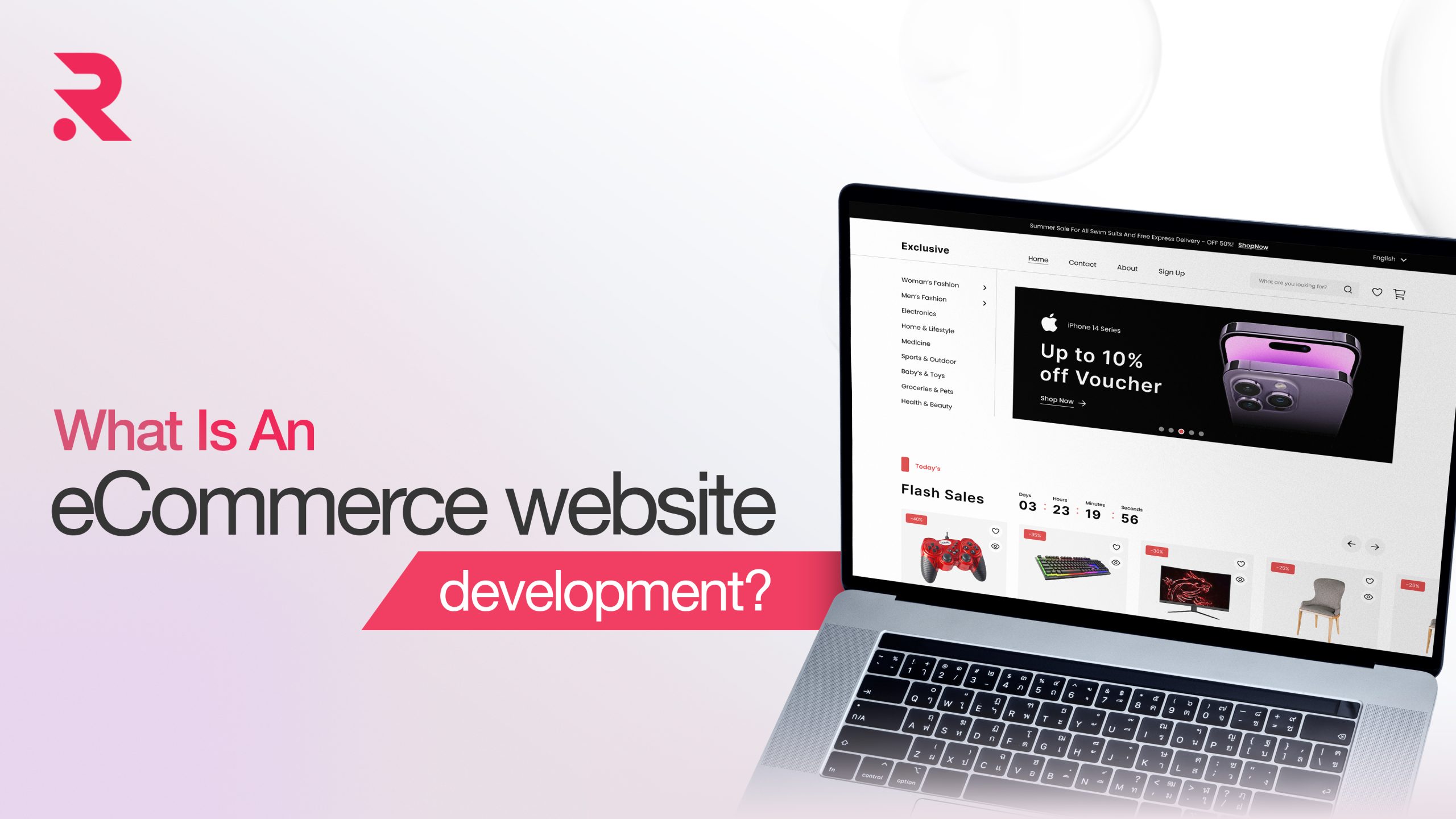All about Ecommerce website development- What, Why and How?
Are you wondering what exactly is an ecommerce website, and why is it so crucial for businesses today? Or how do you go about eCommerce website development and what are the key features and platforms you should consider? Then dive into this 2025 guide to ecommerce website development to find answers to these questions and more.
- November 1, 2023
- by Tarun

What Is an Ecommerce website development?
An eCommerce website, also known as an online store or digital marketplace, is a platform where businesses showcase and sell their products or services to a global audience over the internet. It serves as a virtual storefront, providing customers with a convenient and accessible way to browse, compare, and purchase goods or services from the comfort of their homes.
The process of creating and constructing an ecommerce storefront where customers may make purchases is known as ecommerce web development. Because ecommerce websites are so well-liked by customers, creating an ecommerce website can increase conversions and income for your company.
They come with two options one you can choose to build from Scratch and customise it as per your business requirements and second is prebuild themes and you can drag and drop elements or add as per your likings.
Custom Ecommerce website development involves creating tailored online platforms that cater to businesses’ specific needs and preferences. This process typically includes designing and implementing unique features, functionality, and branding elements to differentiate the website and enhance the user experience.
Basically, an eCommerce website acts as a dynamic marketplace, bridging the gap between sellers and buyers by offering a seamless and secure platform for online transactions.
A Prime Example of Successful ecommerce website
A prime example from the London eCommerce market is “ASOS.”
ASOS has gained international recognition as one of the largest online fashion retailers, offering a vast selection of clothing, accessories, and beauty products from both established brands and emerging designers.
Like Amazon, ASOS provides a full shopping experience within a digital platform. Customers can browse through a diverse range of styles, access detailed product descriptions, and enjoy convenient features such as saved payment methods and personalised recommendations.
In essence, ASOS exemplifies how eCommerce platforms can transcend geographical boundaries, becoming iconic destinations for fashion enthusiasts worldwide while revolutionising the way we shop for clothing and accessories.
Why is Ecommerce Web Development Important?
There are between 12 and 24 million active ecommerce websites worldwide, so it’s simple for an online store to become lost in the shuffle.

Ecommerce website development is of paramount importance, particularly in the face of unprecedented events like the COVID-19 pandemic, which have profoundly impacted businesses worldwide.
Why is Ecommerce Web Development Important?
Resilience During Crises
Ecommerce provided critical resilience during the pandemic, enabling businesses to continue operations when physical stores closed. Restaurants and retailers pivoted to online ordering and delivery services, maintaining business continuity during lockdowns.
Adaptability to Changing Consumer Behavior
The pandemic drastically shifted consumer behavior, emphasising ecommerce’s need for adaptability. Businesses quickly enhanced their online platforms to meet new demands, such as grocery stores expanding their online shopping capabilities to accommodate increased contactless shopping.
Enhanced Customer Engagement
Ecommerce facilitates personalised customer interactions, boosting engagement. During the pandemic, businesses like Netflix leveraged these features to offer tailored experiences, increasing subscriptions and retention rates.
Ecommerce platforms streamline order processing, crucial during health crises. Robust systems for payments and order management enabled safe, contactless transactions. Platforms like Shopify and WooCommerce ensured seamless online sales during the pandemic.
The web development services sector, worth $80 billion in 2025, provides a means for entrepreneurs to create user-friendly websites and address their most urgent ecommerce problems.
Looking a technical partner to help grow your Ecommerce store?
Our Experts Can Help!
Options for Building an Ecommerce Website
When choosing an ecommerce platform, it’s essential to consider the different types available, each suited to various business needs and functionalities.
Here’s an overview of the three main types:
Open Source
What it is: Open-source platforms provide their code for free, allowing anyone to use and modify it as per their requirements.
Pros:
- Free to install: No initial cost for acquiring the software.
- Highly customisable: Users can modify the code to tailor the platform to their specific needs.
Cons:
- equires advanced coding skills: Utilising and customising open-source platforms typically demands proficiency in programming languages.
- Potential security issues: Because the source code is accessible to all, there might be vulnerabilities that could be exploited.
- May incur additional maintenance costs: Ensuring security and managing updates may require hiring dedicated personnel, potentially leading to higher overall expenses.
SaaS (Software as a Service)
What it is: SaaS platforms offer ecommerce solutions as subscription services, providing a ready-to-use solution for businesses.
Pros:
- Easy to use: Designed with user-friendliness in mind, requiring little technical expertise.
- Scalable: Capable of accommodating business growth without significant technical adjustments.
- Strong security features: Typically come with built-in security measures to safeguard transactions and customer data.
Cons:
- Monthly subscription fees: Businesses need to pay regular subscription charges to access the service.
- Transaction fees and additional costs for plug-ins: Additional expenses may be incurred for specific functionalities or third-party integrations.
- Possible branding restrictions: Some SaaS platforms impose limitations on branding, potentially affecting the customisation options available to businesses.
MACH Architecture:
MACH stands for microservices, API-first, cloud-native SaaS, and headless. It is a set of guidelines for creating corporate software tech stacks utilising the best-of-breed methodology. In contrast to monolithic architecture, MACH gives you the freedom to select the technology that best suits your long-term goals and business requirements.
Microservices:
- What it is: Architectural approach where applications are built as a collection of small, independently deployable services.
- Pros: Each service can be developed, deployed, and scaled independently, enhancing agility and scalability.
- Cons: Managing multiple services might add complexity to the system.
API-first:
- What it is: Design principle where all functionalities are accessible through well-defined APIs.
- Pros: Enables seamless integration with other systems and services, fostering interoperability.
- Cons: Requires robust API management to ensure security and reliability.
Cloud-native:
- What it is: Development and delivery approach that leverages cloud computing infrastructure.
- Pros: Offers scalability, flexibility, and cost-effectiveness by utilising cloud resources.
- Cons: Reliance on cloud service providers, potentially introducing dependencies and vendor lock-in.
Headless:
- What it is: Decoupling of the frontend (user interface) from the backend (business logic and data), allowing for independent development and customisation.
- Pros: Facilitates rapid changes to customer interfaces and enables high levels of customisation.
- Cons: Requires expertise in set up and management due to the separation of front-end and back-end functionalities.
Summary
- Open Source: Offers flexibility and customisation but requires coding skills and may pose security risks.
- SaaS: Provides ease of use and scalability but involves subscription fees and potential branding limitations.
- MACH Architecture: Incorporates Microservices, API-first, Cloud-native, and Headless principles for modern, flexible ecommerce solutions, though it may entail complexities in management and setup.
How to Develop an Ecommerce Website?
There are several processes involved in developing an effective ecommerce website. Follow these steps to create a successful online store:
Define Your Business Goals and Niche
Start by clarifying your business objectives, identifying your target audience, and pinpointing your niche market. This foundation will guide your website’s design and functionality.
Select a Domain Name and Hosting
Choose a domain name that represents your brand and is easy to remember. Select reliable web hosting services to ensure your website is accessible 24/7.
Choose the Right Ecommerce Platform
Pick an ecommerce platform that fits your business needs. Options include:
- Shopify: User-friendly interface
- WooCommerce: Flexible and integrates with WordPress
- Magento): Ideal for Medium to larger enterprises
- Adobe Commerce: Ideal for larger enterprises
- BigCommerce: Great built-in features for fast-growing businesses.
Want to learn how to choose the correct ecommerce platform for your business?
Our blog offers detailed insights and expert advice Check here.
Design Your Website
Design a visually appealing, user-friendly design that reflects your brand identity. You can hire a web designer or use customisable ecommerce templates. Ensure your design is mobile-responsive.
Set Up Product Listings
Create detailed product listings with high-quality images, compelling descriptions, transparent pricing, and categories for easy navigation.
Integrate a Secure Payment Gateway, ERP and CRM
Integrate a secure payment gateway like PayPal, Stripe, or Authorise.net, and implement SSL encryption to protect customer data. Additionally, enhance your operations by integrating ERP and CRM systems.
ERP integration synchronises financial data, inventory, and order processing, while CRM integration manages customer interactions, improves service, and aids marketing.
Implement Shopping Cart and Checkout
Ensure your shopping cart integration allows users to add products, review their selections, and complete the checkout process effortlessly, reducing cart abandonment rates.
Implement Website Security Measures
Protect your website with regular updates, strong password protocols, and a web application firewall (WAF) to guard against cyber threats.
Optimise for SEO
Improve your website’s visibility by optimising for search engines. Conduct keyword research, optimise meta tags and images, and create high-quality, relevant content to boost search rankings.
Up Analytics and Tracking
Use web analytics tools like Google Analytics to track traffic, user behavior, and sales. Use these insights to refine your marketing strategies and drive growth.
Test and Quality Assurance
Perform thorough testing across various devices and browsers to ensure seamless functionality and compatibility. Fix any bugs or broken links before launching.
Launch Your Website
Once everything is in place, launch your website. Promote it through strategic marketing initiatives to attract visitors and drive traffic.
Market Your Ecommerce Website
Implement a comprehensive digital marketing strategy, including social media, email, content marketing, and paid advertising, to promote your website and attract customers.
Provide Ongoing Maintenance
Update your website regularly, add new products, and adjust marketing efforts based on customer feedback. Continuously improve the user experience to stay competitive.
Monitor and Scale
Monitor performance metrics, sales data, and customer feedback. As your business grows, consider scaling up by adding new features or expanding your product range.
By following these steps, you can develop a robust ecommerce website that showcases your products and provides an excellent shopping experience for your customers.
List of Essential eCommerce Features Your Website Must Have
Do you want to know some of the essential features your websites must have? Here we have made a list of essential features that you need to include on your ecommerce website. However, always remember that in the ecommerce world there is no one strategy that fits all. You must experiment and see which results match your website objectives.
Some of the essential features your website must include:
User-Friendly Navigation Menu
Excellent user interface (UI) and user experience (UX) design are essential components of a successful ecommerce website. A clear and intuitive navigation menu is crucial for helping users find products easily. Consider a well-organised menu with categories and subcategories, like Amazon’s menu, which allows users to browse effortlessly through various product sections.
Product Catalogue
Your product catalogue serves as the heart of your ecommerce website. Each product should have a dedicated page with detailed information, high-quality images, pricing, and customer reviews. For instance, Apple’s website elegantly showcases each product with comprehensive descriptions and images.
Secure Payment Gateway
Ensuring that your website offers a secure payment gateway is paramount. Customers need to trust that their payment information is safe. PayPal, for instance, is a widely trusted payment gateway used by numerous ecommerce websites, providing peace of mind to customers. Furthermore, you should offer multiple payment options to your clients so that they can choose the method that suits them best.
Shopping Cart
The shopping cart is where users can view and manage their selected items before making a purchase. It’s like a digital shopping basket. Amazon’s shopping cart, for instance, allows users to review their selections, adjust quantities, and proceed to checkout seamlessly.
Search Functionality
An effective search function is essential for users who know exactly what they’re looking for. It’s akin to a store associate helping customers find specific items quickly. eBay’s search feature, for example, enables users to search for products using various filters, making the shopping process efficient.
Product Recommendations
Implementing a product recommendation system can significantly boost sales and customer satisfaction. Netflix, for instance, uses advanced algorithms to suggest movies and series based on a user’s viewing history, making the user experience more personalised and engaging.
User Reviews and Ratings
Customer reviews and ratings provide valuable social proof and help potential buyers make informed decisions. Amazon’s product pages prominently display customer reviews, allowing shoppers to assess product quality and reliability.
Want to Build Your First Ecommerce Website?
We Can Help!
Mobile Responsiveness
With the increasing use of smartphones, ensuring that your website is mobile responsive is crucial. Customers should have a seamless shopping experience on both desktop and mobile devices. Shopify, for instance, offers responsive themes for mobile optimisation.
Site Speed
Google’s research highlights a critical insight: every additional second in page load time significantly increases the likelihood of visitors bouncing. Beyond user experience, a fast-loading site is crucial for SEO, as Google considers site speed a ranking factor. Therefore, it is essential to work with ecommerce website developers who can optimise your store to be not only functional and visually appealing but also swift in performance.
SEO Capabilities
SEO is an indispensable tool for content distribution and a key component of effective website design. Achieving high rankings on Google for pertinent keywords can attract a stream of interested users actively searching for your offerings. This organic traffic tends to consist of high-intent visitors who are more likely to convert, making SEO a highly cost-effective traffic source.
Looking to choose the best SEO agency for your business?
Our blog offers detailed insights and expert advice Here is a complete guide for you.
Product Management
Think about your go-to online store. They likely maintain a robust inventory, offer a variety of product options, and provide timely promotions and discounts. To ensure your ecommerce site meets these standards, it must include features that allow you to efficiently manage and track inventory, ensuring you always meet customer demand with the right products.
5 Popular Ecommerce Platforms

Here’s a detailed list of popular eCommerce platforms and integrations along with a more comprehensive example:
Shopify
Shopify is a versatile and user-friendly ecommerce platform suitable for businesses of all sizes. It offers a wide range of customisable templates and integrates seamlessly with numerous apps and services. For example, Shopify’s integration with Facebook and Instagram allows you to set up a Facebook Shop, making it easy for customers to browse and purchase products directly through these social media platforms. This expands your reach and provides a convenient shopping experience.
Magento
Magento is a robust and highly customisable open-source ecommerce platform, making it ideal for large enterprises with complex requirements. It offers various integrations for analytics and marketing, including Google Analytics and Adobe Analytics. These integrations provide deep insights into customer behaviour and help refine marketing strategies to boost sales.
BigCommerce
BigCommerce is known for its scalability and built-in features, making it a great choice for growing businesses. It offers integrations with marketing tools like Mailchimp and HubSpot. For instance, integrating with Mailchimp allows you to create targeted email campaigns, segment your audience, and automate marketing efforts to engage customers effectively.
WooCommerce
WooCommerce is a plugin for WordPress, making it a suitable option for those who prefer the flexibility of WordPress combined with ecommerce capabilities. It integrates seamlessly with Google Analytics, which provides valuable data on website traffic, conversions, and user behaviour. With this integration, you can optimise your site’s performance and tailor your marketing efforts accordingly.
Adobe Commerce
Adobe Commerce is a robust platform that merges ecommerce, customer relationship management (CRM), and marketing automation. It features seamless integrations with AI-driven analytics tools such as Adobe Sensei. This powerful combination allows you to gain deep insights into customer preferences, predict buying behaviors, and deliver personalised shopping experiences, ultimately boosting conversions and fostering customer loyalty.
How to Work with an eCommerce Developer?
Do you want to avoid all the hassle of developing the ecommerce website on your own? or if you lack technical expertise, collaborating effectively with an ecommerce developer or team is key to building a successful online venture.
First, define your project needs and goals clearly. Research and select a developer or Web Development Company with relevant experience and establish a realistic budget and timeline.
Maintain open communication channels throughout the project and agree on milestones. Prioritise user testing and quality assurance to ensure a seamless user experience. Request training and documentation for your team’s benefit. Collaborate closely during the launch and discuss post-launch support and feedback mechanisms. By following these steps and fostering clear communication, you can ensure a productive partnership with your ecommerce developer, ultimately leading to a successful website.
Final Words
Ecommerce website development is a dynamic field that constantly evolves to meet changing consumer expectations. Staying updated with the latest trends and technologies is vital for long-term success. Remember that success in ecommerce requires dedication, strategic planning, and a commitment to providing exceptional user experiences.
Do you want to develop your website? RVS Media offers the best website development services in London. Our team develops a customised strategy according to your needs and preferences. Book your consultation now and take your business to the next level.
FAQs
What is the difference between an ecommerce website and a regular website?
An ecommerce website is made for online buying and selling of goods or services and is equipped with functions like shopping carts, secure payment gateways, and product catalogues. On the other hand, a generic website can be any website serving a variety of purposes, like providing information about a company, presenting a portfolio, or hosting a blog, without being involved in direct transactions.
Will My Online Store Deliver a Seamless Mobile Experience?
Absolutely. In 2025, from a mobile aspect, the seamless experience is no longer viewed as a luxury but an absolute must-have for all ecommerce companies. Already, buyers consider the mobile channel as the primary means of transacting globally; in the UK alone, these sales will go beyond £100 billion in 2025. As mobile remains the preferred device, being able to handle that traffic becomes listed as the first parameter for evaluation of an ecommerce website because an unresponsive website increases the chances of abandonment by 61%. On top of improving the user experience, mobile-responsive design enhances your visibility in search engines such as Google, giving you an edge that ranks above your competitors.
How much does it cost to develop an ecommerce website in 2025?
The cost of developing an ecommerce website can vary widely depending on factors like the platform chosen, the complexity of the design, the number of products, and additional features. It can range from a few hundred dollars to several thousand or more. Check detailed costing breakdown in this blog. (add link to cost of website blog)
What are the security measures I should take to protect customer data on my ecommerce website?
In 2025, keeping your customers’ data safe is more important than ever. At the very least, make sure your site uses SSL encryption—this keeps data secure while it’s being sent back and forth.
- Use strong, unique passwords for every account and stay on top of updates—for both your site platform and any plugins you’re using. Outdated software is basically an open door for hackers.
- It’s also worth looking into a web application firewall (WAF). It can help block more advanced threats, especially with the rise of AI-powered attacks and ransomware.
- Multi-factor authentication (MFA) is another must-have. It might feel like a small step, but it stops about 99.9% of automated attacks.
- And if you’re handling payments? Make sure you’re PCI DSS compliant. It’s not just a best practice—it’s a requirement for processing card data safely.
What are some emerging trends in ecommerce website development for 2025?
Ecommerce in the UK is all about smarter, faster, and more personal experiences this year. AI is helping brands customise everything—from product suggestions to pricing. AR is becoming normal too—shoppers can now try on clothes or preview furniture right from home.
Headless setups are making sites faster and easier to manage, while voice search is growing as more people shop using Alexa or Siri. Social media is turning into a major sales channel—63% of Brits have bought something directly through a platform, and that number’s only going up.
Lastly, shoppers care more than ever about sustainability. Eco-friendly packaging and ethical practices aren’t just nice—they’re expected.
How can I provide excellent customer support on my ecommerce website?
To give great customer support, it helps to offer a few easy ways for people to reach you—like live chat, email, and clear contact info. Adding AI chatbots can handle quick questions 24/7, so your team can focus on the tougher stuff.
Marketing automation’s also useful for sending the right message at the right time. And don’t underestimate the power of a quick, kind reply—it really goes a long way. Self-service options like FAQs or help centres are also a win for shoppers who like to figure things out on their own.
 Shopify
Shopify




















